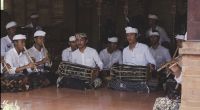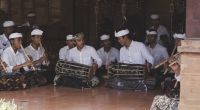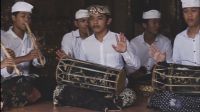- Type of Performance
- Music
- Photo reference
- Dokumentasi pementasan oleh Arya Bisma
- Genre
- Musik Tradisi
- Composer
- I Wayan Arya Bisma
- Musicians, group or orchestra
- Sekaa Suling Nika Manu
- Sanggar Seni Cudamani
- Place of origin
- Banjar Pengosekan Kaja, Desa Mas, Ubud, Gianyar, Bali
- Instruments
- Gamelan Semarandana
- Related Books
- Related Holidays
Videos
Description
In English
This musical composition uses the Tri Angga structure, namely: Kawitan, Pengawak and Pengecet, but in each section it is divided into several more sub-sections. In each section there is a gending penyalit or transition, which is a road or bridge to achieve the goal.
Music Composition Structure : 1. Kawitan (beginning) a. The composition started with pengalian section which is begins with the riyong instrument playing and continues with all the instruments. By playing several types of patets, such as: Pengeter Agung, Sunaren and Selendro Agung. b. In the pepeson section there are two parts, namely: part A and part B, and the composition is A-A-penyalit-B-B. In part A uses the patet Selendro Agung , and in this section there are terompong instruments patterns such as ngembat and nyilih asih, but it played on the riyong instrument. After that continue to the shorter penyalit section, using the patet Sunaren, Tembung and Pengeter Agung. 2. Penyalit section is the connecting part between the kawitan and the pengawak section. In this penyalit section using the kebyar pattern with patet Pengeter Agung and at the end there is a modulation to the patet Selendro Alit. 3. Pengawak section is a simplification of the Legod Bawa form taken from gending pelegongan. In this section highlighted the flute instrument and also uses patet Selendro Alit and at the end there is a modulation to the Sunaren patet. 4. Penyalit, in this penyalit part it is the bridge between the pengawak part and the pengecet. This section uses the form of pengetog compositions, which are developed with an arbitrary count. This section uses patet Sunaren and patet Pengeter Agung. 5. Pengecet section is divided into 3 parts, namely: part A, B and pekaad section. Composed with the pattern A-penyalit-B-penyalit-A-peyalit-B-penyalit-pekaad (ending). Part A adopts the nyong-nyong instrument pattern from the Barungan Gamelan Selonding, with a simple melody and uses patet Pengeter Agung, then continues with the penyalit to get to part B which still uses patet Pengeter Agung. This part highlighted the dynamics of the gangsa and kantilan instruments. The riyong, penyacah and calung instruments adorn it with the same gending pattern. Part B uses patet Sunaren, then followed by penyalit that are using patet Sunaren and Tembung. And the ending or pekaad part uses the kebyar pattern with Patet Pengeter Agung and Selendro Alit. And then in the very last part of the composition, there is a Leluangan drums pattern.
The musical composition of this welcoming dance is played in the Gamelan Semarandana. Gamelan Semarandana is a combination of Gamelan Gong Kebyar and Gamelan Semar Pagulingan, which was created by I Wayan Beratha in 1987. The use of Semarandana gamelan is because it has a wider range of tones and octaves, making it possible to be more creative and flexible in composing the song. The creation of this dance music composition "Átmanà Shanti" was supported by Sanggar Seni Çudamani and the Sekaa Suling Semeton Nika Manu.In Balinese
tman santhi inggih punika komposisi karawitan anggen ngiringan tari penyambutan sane karipta olih Wayan Arya Bisma. Ipun mawit sakeng banjar Pujung Kelod, Desa Sebatu, Tegallalang, Gianyar. Arya Bisma sedeng melajahang raga dados mahasisya ring Institur Seni Indonesia Denpasar. tman kasuksmane manah, utawi kayun. Santhi madue kasuksman damai utawi rahayu. tman santhi yening kajangkepan prasida madue arti pikayun sane becik utawi manah sane rahayu. Yening paiketane sareng tari penyambutan madue kasuksman pinaka penyanggra antuk manah sane rahayu. Unteng pikayun sakeng garapan puniki inggian nganinin indik kawentenan kayun Manusa sane setata matiosan turmaning mabinayan. Indike punika prasida kacihnayang sakeng patet utawi saih sane kecag-kecog kaanggen ngewangun garapan puniki. Taler sikut tabuh ring soang-soang anggane nenten tetep utawi matiosan.
Wangun sakeng tabuh punik kakepah dados tiga, inggih punika: Kawitan, Pengawak, Pengecet. Ring sekancan pah-pahan punika malih kakepah dados makudang-kudang baga. Punika taler ring baga-bagane punika kadagingin gending penyalit, pinaka penuntun utawi margi anggen nuju baga selanturnyane.
Wangun Komposisi Musik 1. Kawitan i. Tabuh puniki kakawitin antuk reong, raris kelanturan olih piranti gamelan sami. Patet sane kaanggen ring baga puniki sekadi patet Pangeter Agung, Sunaren, Selendro Agung. ii. Ring baga pepeson kakepah dados kalih inggih punika miwah B. Sane kasusun antuk penyalit B. Ring baga nganggen patet selendro Agung. Ring baga puniki nganggen teknik trompong ngembat miwah nyilih asih, sakemaon kabaktayang olih reong. Raris kelanturang ring baga penyalit sane bawak pisan nganggen patet sunaren, tembung, pangeter Agung. 2. Penyalit, baga penyalit puniki dados titi pengancan sakeng kawitan nuju pengawak. Penyalit puniki medaging kebyar nganggen patet pangenter agung tur kelanturan antuk modulasi nganggen patet selendro alit. 3. Pengawak, ring baga pengawak, Bisma nganggen pola sakeng tabuh palegongan legod bawa. Pengawak puniki sang pengrawit taler ngunggulang suaran suling antuk nganggen patet selndro alit rari kelanturang modulasi nganggen patet sunaren. 4. Penyalit, ring baga penyalit puniki taler pinaka titi anggen nuju ka baga pengecet. Iriki taler nganggen pola pengetog sane ketekan kajarnyane nenten ajeg. Patet sane kaangen inggih punika Sunaren lan pengenter agung. 5. Pengecet, ring baga kakepah dados 3. Nggih punika A, miwah Pekaad. Pola penyalit penyalit penyalit penyalit Pekaad. Ring pola nganggen teknik nyongnyong sane mawit sakeng gending selonding, turmaning nganggen patet pengenter Agung. Raris kelanturang antuk penyalit raris nuju ke pola B. Ring pola sane dados unteng inggih punika gangsa, kantilan, reong, penyacah miwah calung pinaka pemanis. Raris ngelantur ke penyalit malih nganggen patey sunaren miwah tembung. Raris ring pekaad nganggen patet pangenter Agung miwah selendro alit. Taler ring baga pekaad medaging akidik gedig kekebyaran, miwah ring baga kendang nganggen pola leluangan. Komposisi tabuh tari penyambutan puniki nganggen gamelan Semarandhana. Gamelan semarandhana pinaka angkepan sakeng gamelan gong kebyar sareng hamelan semara pegulingan sane karipta olih bapak Wayan Beratha duk waesa 1987. Napi mawinan Bisma nganggen gamelan semarandhana, santukan makueh ngamolihang patet, don gamelan sane akeh prasida dangan antuk mayasin gendinge puniki. Garapan tman Santhi kasarengin olih yowana sakeng Sanggar udamani taler Sekaa Suling Nika Manu sakeng pengosekan.
Átmanà santhi inggih punika komposisi karawitan anggen ngiringan tari penyambutan sane karipta olih I Wayan Arya Bisma. Ipun mawit sakeng banjar Pujung Kelod, Desa Sebatu, Tegallalang, Gianyar. Arya Bisma sedeng melajahang raga dados mahasisya ring Institur Seni Indonesia Denpasar. Átmanà kasuksmane manah, utawi kayun. Santhi madue kasuksman damai utawi rahayu. Átmanà santhi yening kajangkepan prasida madue arti pikayun sane becik utawi manah sane rahayu. Yening paiketane sareng tari penyambutan madue kasuksman pinaka penyanggra antuk manah sane rahayu. Unteng pikayun sakeng garapan puniki inggian nganinin indik kawentenan kayun I Manusa sane setata matiosan turmaning mabinayan. Indike punika prasida kacihnayang sakeng patet utawi saih sane kecag-kecog kaanggen ngewangun garapan puniki. Taler sikut tabuh ring soang-soang anggane nenten tetep utawi matiosan.Wangun sakeng tabuh punik kakepah dados tiga, inggih punika: Kawitan, Pengawak, Pengecet. Ring sekancan pah-pahan punika malih kakepah dados makudang-kudang baga. Punika taler ring baga-bagane punika kadagingin gending penyalit, pinaka penuntun utawi margi anggen nuju baga selanturnyane.
Wangun Komposisi Musik 1. Kawitan i. Tabuh puniki kakawitin antuk reong, raris kelanturan olih piranti gamelan sami. Patet sane kaanggen ring baga puniki sekadi patet Pangeter Agung, Sunaren, Selendro Agung. ii. Ring baga pepeson kakepah dados kalih inggih punika A miwah B. Sane kasusun antuk A A penyalit B B. Ring baga A nganggen patet selendro Agung. Ring baga puniki nganggen teknik trompong ngembat miwah nyilih asih, sakemaon kabaktayang olih reong. Raris kelanturang ring baga penyalit sane bawak pisan nganggen patet sunaren, tembung, pangeter Agung. 2. Penyalit, baga penyalit puniki dados titi pengancan sakeng kawitan nuju pengawak. Penyalit puniki medaging kebyar nganggen patet pangenter agung tur kelanturan antuk modulasi nganggen patet selendro alit. 3. Pengawak, ring baga pengawak, Bisma nganggen pola sakeng tabuh palegongan legod bawa. Pengawak puniki sang pengrawit taler ngunggulang suaran suling antuk nganggen patet selndro alit rari kelanturang modulasi nganggen patet sunaren. 4. Penyalit, ring baga penyalit puniki taler pinaka titi anggen nuju ka baga pengecet. Iriki taler nganggen pola pengetog sane ketekan kajarnyane nenten ajeg. Patet sane kaangen inggih punika Sunaren lan pengenter agung. 5. Pengecet, ring baga kakepah dados 3. Nggih punika A, B miwah Pekaad. Pola A penyalit B penyalit A penyalit B penyalit Pekaad. Ring pola A nganggen teknik nyongnyong sane mawit sakeng gending selonding, turmaning nganggen patet pengenter Agung. Raris kelanturang antuk penyalit raris nuju ke pola B. Ring pola B sane dados unteng inggih punika gangsa, kantilan, reong, penyacah miwah calung pinaka pemanis. Raris ngelantur ke penyalit malih nganggen patey sunaren miwah tembung. Raris ring pekaad nganggen patet pangenter Agung miwah selendro alit. Taler ring baga pekaad medaging akidik gedig kekebyaran, miwah ring baga kendang nganggen pola leluangan.
Komposisi tabuh tari penyambutan puniki nganggen gamelan Semarandhana. Gamelan semarandhana pinaka angkepan sakeng gamelan gong kebyar sareng hamelan semara pegulingan sane karipta olih bapak I Wayan Beratha duk waesa 1987. Napi mawinan Bisma nganggen gamelan semarandhana, santukan makueh ngamolihang patet, don gamelan sane akeh prasida dangan antuk mayasin gendinge puniki. Garapan Átmanà Santhi kasarengin olih yowana sakeng Sanggar Çudamani taler Sekaa Suling Nika Manu sakeng pengosekan.In Indonesian
Komposisi musik ini menggunakan struktur Tri Angga, yaitu: Kawitan, Pengawak dan Pengecet, tetapi dalam setiap bagian dibagi menjadi beberapa sub bagian lagi. Pada setiap bagian terdapat sebuah gending penyalit atau peralihan yakni jalan atau jembatan untuk mencapai tujuan.
Struktur Komposisi Musik 1. Kawitan a. Pengalian diawali dengan permainan istrumen riyong dan dilanjutkan dengan permaianan seluruh instrumen. Dengan memainkan beberapa jenis patet, seperti: Pengeter Agung, Sunaren dan Selendro Agung. b. Pada bagian pepeson terdapat dua bagian, yaitu: bagian A dan bagian B, bagian ini dikomposisikan menjadi : A-A-Penyalit-B-B. Pada bagian A menggunakan patet Selendro Agung, dimana pola permainan instrument terompong seperti ngembat dan nyilih asih dipresentasikan pada instrument riyong. Lalu berlanjut ke bagian penyalit yang durasinya lumayan pendek, dengan menggunakan patet Sunaren, Tembung dan Pengeter Agung. 2. Penyalit, bagian ini merupakan bagian penghubung antara bagian kawitan dangan bagian pengawak. Menggunakan pola permainan kebyar, dengan patet Pengeter Agung dan pada bagian akhir terdapat modulasi ke patet Selendro Alit. 3. Pengawak, bagian ini merupakan penyederhanaan bentuk gending legod bawa yang ada pada gending pelegongan. Pada bagian ini menonjolakan permainan suling. Patet yang digunakan adalah Selendro Alit dan pada bagian akhir terdapat modulasi ke patet Sunaren. 4. Penyalit, bagian penyalit ini menjadi penghubung antara bagian pengawak dengan bagian pengecet. Pada bagian ini menggunakan bentuk gending pengetog, yang dikembangkan dengan hitungan yang tidak tetap. Bagian ini menggunakan patet Sunaren dan Pengeter Agung. 5. Pengecet, bagian ini dibagi menjadi 3 bagian, yaitu : bagian A, B dan bagian pekaad. Dikomposisikan dengan pola A-penyalit-B-penyalit-A-peyalit-B-penyalit-pekaad. Pada bagian A mengadopsi pola permainan instrument nyong-nyong pada barungan Gamelan Selonding, dengan melodi yang sederhana dan menggunakan patet Pengeter Agung, lalu dilanjutkan dengan penyalit untuk menuju bagian B yang tetap menggunakan patet Pengeter Agung. Selanjutnya pada Bagian B, menonjolkan dinamika instrument gangsa dan kantilan. Instrument riyong, penyacah dan calung menghiasi dengan pola gending yang sama. Patet yang digunakan adalah patet Sunaren, lalu dilanjutkan dengan penyalit yang menggunkan patet Sunaren dan patet Tembung. Pada bagian akhir atau pekaad menggunakan pola permainan kebyar, dengan menggunakan patet Pengeter Agung dan Selendro Alit. Lalu pada bagian paling akhir lagu terdapat sedikit pola permainan kendang Leluangan.
Komposisi musik iringan tari penyambuatan ini ditabuhkan dalam gamelan Semarandana. Gamelan Semarandana merupakan kombinasi dari Gamelan Gong Kebyar dan Gamelan Semar Pagulingan, yang diciptakan oleh I Wayan Beratha pada tahun 1987. Penggunaan gamelan Semarandana dikarenakan barungan gamelan Semarandana memiliki cakupan nada dan oktaf yang lebih luas, sehingga memungkinkan untuk bisa berkreativitas lebih luas dan leluasa dalam mengolah lagu, seperti halnya pengolahan patet dan ukuran lagu. Terciptanya komposisi music tari “Átmanà Shanti” didukung oleh Sekaa Gong Remaja Sanggar Seni Çudamani dan Sekaa Suling Semeton Nika Manu.In other local languages
Audios
Photos
Articles









Enable comment auto-refresher